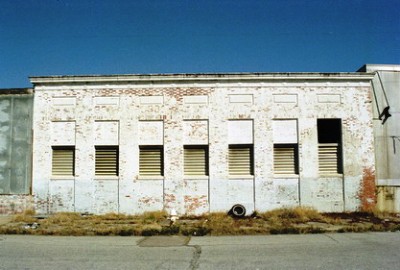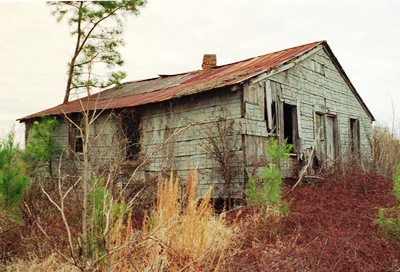
This post is dedicated to rockabilly pioneer Hasil Adkins, of Boone County, West Virginia. Hasil was found dead in his home today at the age of 67. A one-man band, Hasil played guitar, drums, and sang, all at once, 'cause that's the way he thought it was done when he first heard the music on the radio. A one-of-a-kind original, Hasil conjured the most primitive music imaginable, and I am happy to say I saw him perform once, in Athens, GA. He was supposed to go on around 11:30 PM, but took the stage sometime after 2:30 AM. Over the course of the next 45 minutes he screamed, groaned, moaned, and sang a little, too. At the end, he threw his guitar at a cymbal, kicked over his drums, and stomped off stage with a big grin on his face. So, for Hasil, we'll start this post with a tune. This ditty was sung by Charlie Patton, Leadbelly, and Blind Lemon Jefferson, among others. It's about the bug that tore the South apart.
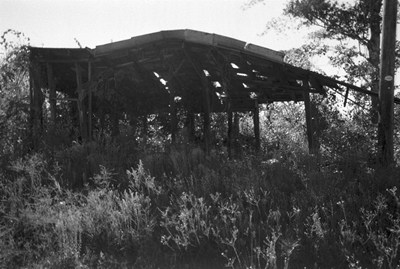
Mississippi Boweavil Blues: "Sees a little boweavil keeps movin' in; You can plant your cotton and you won't get a half a bale; Boweavil, boweavil, where's your native home?; A-Louisiana raised in Texas, least is where I was bred and born; Well, I saw the boweavil, Lord, a-circle, Lord, in the air; The next time I seed him, Lord, he had his family there; Boweavil left Texas, Lord, he bid me: fare ye well; (spoken: Where you goin' now?); I'm goin' down the Mississippi, gonna give Louisiana hell; (spoken: How is that, boy?); Suck all the blossoms and he leave your hedges square; The next time I seed you, you know you had your family there; Boweavil meet his wife: We can sit down on the hill; Boweavil told his wife: Let's trade this forty (acres) in; Boweavil told his wife, says: I believe I may go North; (spoken: Hold on, I'm gonna tell all about that); Let's leave Louisiana, we can go to Arkansas; Well, I saw the boweavil, Lord a-circle, Lord, in the air; Next time I seed him, Lord, he had his family there; Boweavil told the farmer that: I 'tain't got ticket fare; Sucks all the blossom and leave your hedges square; Boweavil, boweavil, where your native home?; Most anywhere they raise cotton and corn; Boweavil, boweavil, outta treat me fair; The next time I did you had your family there."
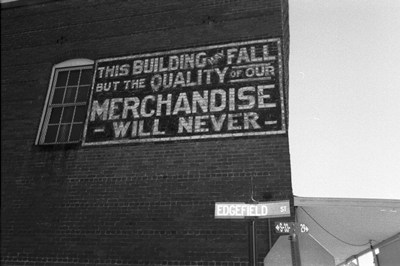
Historically, the South was dominated by agriculture in every way. Whether you were a plantation owner, independent farmer, storekeeper, or sharecropper, your life, and each day in it, revolved around crops. Tobacco was big, corn was not uncommon, but cotton was king. However, as with any king, the reign can't last forever. Before 1900, the boll weevil (Anthonomus grandis grandis) didn't exist in the U.S. Then, right round the turn of the century, an odd little insect with a snout half the length of its body appeared near the Mexican border. It so happened that this new arrival could only reproduce on king cotton, and it used its large snout, complete with vicious chewing apparatus, to drill holes in cotton plants for feeding and depositing eggs. The cotton plant had never had to deal with such a pest before, and so it didn't. Instead, large parts of the cotton plant died and dropped off after infestation by boll weevils. These parts of the plant had previously been highly useful: they produced cotton. As for the photos, we've been to Plum Branch before, haven't we?
Around 1914, the weevil arrived in Georgia. By 1921, the agricultural economy (i.e. MOST of the economy) of much of the South was in tatters. Check out the figures for Hancock County, Georgia, which includes Sparta, just west of Augusta and a bit south of I-20, considered to be one of the hardest hit regions in the entire South. In 1919, 19,789 bales of cotton were produced in Hancock County, at a market price of 40 cents per lb. In 1920, 11,685 bales were produced, but they sold for just 16 cents per lb. By 1921, only 1,509 bales were produced, fetching 17 cents per lb. The price went up in 1922 to 23 cents per lb., but only 710 bales were harvested that year. So, between 1919 and 1922, cotton production in Hancock County fell from 19,789 bales to 710 bales. And similar numbers were recorded all over the South. In 1921, the Sparta Ishmaelite reported that, across the South, 10,000 people were starving as a result of the failure of the cotton crop. Thus the boll weevil precipitated the Great Migration, during which everyone that could get out of the South did, and those that couldn't suffered badly.
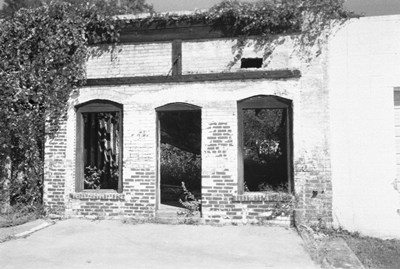
And there appeared to be no way to stop the weevil. In 1921, desperate farmers tried to kill the weevil by spraying their plants with a mixture of cane syrup, water, and calcium arsenate. The only creatures that really died were the farmer's mules, who liked to lick up the sugary mix. RANDOM ASIDE: In Australia, in 1935, an effort was made to control two types of cane beetle by importing 101 cane toads from Hawaii. What the introducers failed to recognize was that the beetles spent most of their time high up in the cane while the toad, at least under its own power, was rarely airborne. The cane toad is now a serious problem in Australia since it eats anything it can fit in its mouth and is poisonous to boot. Yet another example of our complete ineptitude when it comes to managing our own environment. But, uh, back to the story at hand... In some towns, schools and businesses closed one day a week so that people could go to the fields and kill the pests by hand. Along the coast, the sea cotton industry was wiped-out in one year, never to come back. Below is a photo of the painting I mentioned last time we were near Plum Branch. It's just inside the door of the house in the top shot of that post.
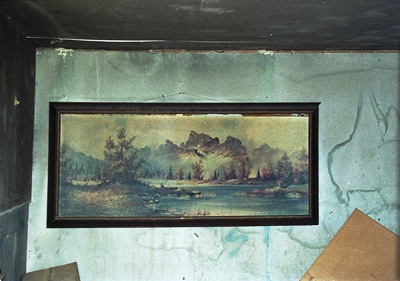
As is often the case in times of economic desperation, even when they result from a force of nature, folks start looking for scapegoats. So it was that in 1921 there were more lynchings in the South than there had been in any year since 1909. In fact, the number of lynchings during each year over the period of worst weevil infestation has been shown to correlate closely (and inversely) with the per acre value of cotton. Also, the Ku Klux Klan began to make large gains in popularity, whereas for the decade or two previous its influence had been much less obvious. Am I suggesting that the boll weevil is responsible for increased attendance at Klan rallies in Georgia? Why, yes, I think I am. There were also some very ugly race-based killings in the state during the weevil years. As literary critic Frederic Jameson has said, "History is what hurts..." The little empty building below is located on Wizard's Cove Dr. and, given the above, the street name might refer to either of two types of wizard. I'd like to think the name comes from the kind of wizard that Black Sabbath sang about, one of which can be seen hovering under the awning.
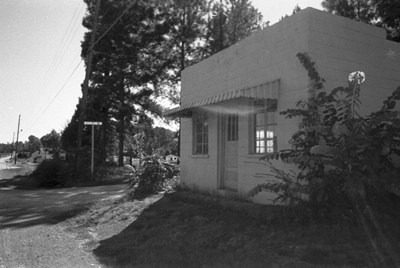
Toward the end of the 1920's, cotton (the plant) was recovering from the weevil a little bit. But cotton (the industry) was not, and never would. Many farmers had switched crops, and untold numbers of people had fled. Those who kept farming cotton often had to spray their crops up to 20 times a year to keep the weevil at bay, killing the beneficial insects that increased yield, as well. And, of course, the Great Depression was right around the corner. Hancock County, once Georgia's leading farm county, would, 50 years later, have a per capita income on par with the poorest parts of the nation. Below is one of the very first photos I ever took of the type you've seen on this site. It was at the end of a roll of shots I took to document my thesis research for school. I was using a Fuji disposable, just before a rain storm, so the color is a little weird. But I never got back to take any additional photos here, so I present this and the shot below it for the record.
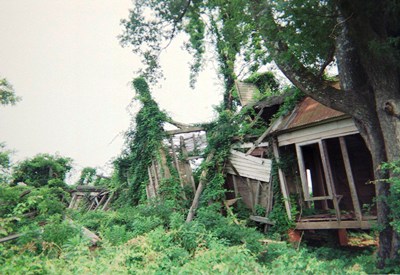
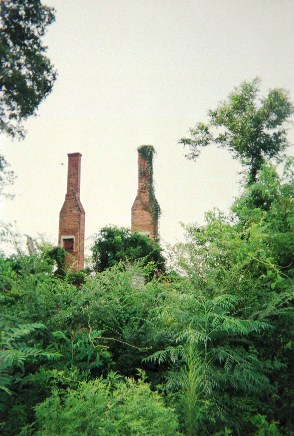 Difficulties with controlling the weevil continued through WWII. By the 1970's, DDT was being used extensively, but we all know how that turned out. Now, chemicals are still being used as insecticides, but genetic means have also been employed in the ongoing fight to bring the weevil to its knees. Yet, for the South, the point is largely moot. The major damage was done long ago. In the span of a couple years, cotton, the king of the South, was reduced to barely a shadow of its former self. A way of life largely vanished, as well. It was a tough, often unfair way of life, without a doubt, but it was all people had known. They then had to find something else; sometimes better, sometimes worse. And it was all because of a little bug with a big nose which, in 2003, for the first time since its arrival in the state, was not detected anywhere in Georgia. Information for this post came from Professor Barbara Foley (although she was discussing Jean Toomer's 1923 book, "Cane"), the University of Tennessee, and UGA. Next time, we'll take a final look at Phinizy Swamp.
Difficulties with controlling the weevil continued through WWII. By the 1970's, DDT was being used extensively, but we all know how that turned out. Now, chemicals are still being used as insecticides, but genetic means have also been employed in the ongoing fight to bring the weevil to its knees. Yet, for the South, the point is largely moot. The major damage was done long ago. In the span of a couple years, cotton, the king of the South, was reduced to barely a shadow of its former self. A way of life largely vanished, as well. It was a tough, often unfair way of life, without a doubt, but it was all people had known. They then had to find something else; sometimes better, sometimes worse. And it was all because of a little bug with a big nose which, in 2003, for the first time since its arrival in the state, was not detected anywhere in Georgia. Information for this post came from Professor Barbara Foley (although she was discussing Jean Toomer's 1923 book, "Cane"), the University of Tennessee, and UGA. Next time, we'll take a final look at Phinizy Swamp.
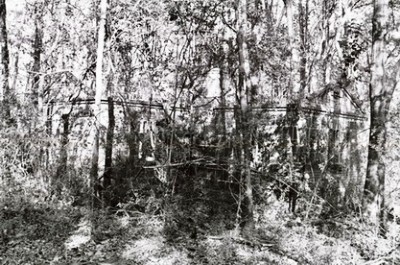
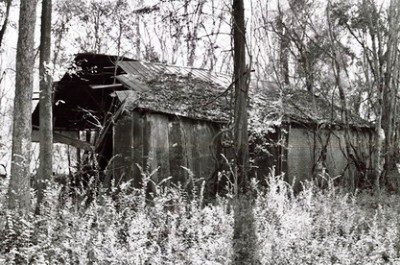
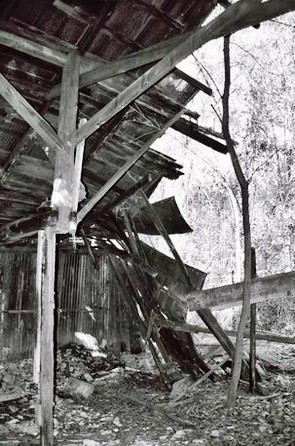 But Hernando was really only interested in getting rich, and became upset once it was clear that the Cofachiqui didn't have any silver, nor knew where to get any. So, with nothing else to do, DeSoto and his men started digging up graves to get at the freshwater pearls that dead people were given. In one grave, amidst the dirt and stones, they found the belongings of DeSoto's brother, Ayllon. Ayllon, it turns out, had unsuccessfully tried to settle in the area a number of years previously, but had died of a nasty bout of plague of one sort or another. As a result, scores of indians had also died of the plague, and many villages had been abandoned. In any case, Hernando was saddened to find the personal effects of his dead brother. To console himself, he kidnapped the Cofachiqui's queen, Cacique, and made-off with 14 bushels of pearls. Many of DeSoto's party had been enjoying themselves and wanted to stay with the Cofachiqui, but Hernando got them moving through SC, and eventually into North Carolina and Tennessee.
But Hernando was really only interested in getting rich, and became upset once it was clear that the Cofachiqui didn't have any silver, nor knew where to get any. So, with nothing else to do, DeSoto and his men started digging up graves to get at the freshwater pearls that dead people were given. In one grave, amidst the dirt and stones, they found the belongings of DeSoto's brother, Ayllon. Ayllon, it turns out, had unsuccessfully tried to settle in the area a number of years previously, but had died of a nasty bout of plague of one sort or another. As a result, scores of indians had also died of the plague, and many villages had been abandoned. In any case, Hernando was saddened to find the personal effects of his dead brother. To console himself, he kidnapped the Cofachiqui's queen, Cacique, and made-off with 14 bushels of pearls. Many of DeSoto's party had been enjoying themselves and wanted to stay with the Cofachiqui, but Hernando got them moving through SC, and eventually into North Carolina and Tennessee. 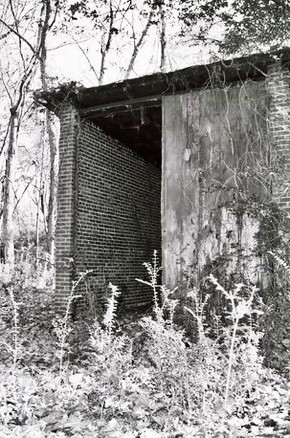 Long after DeSoto and the Spanish, in 1685, the first English colonists in the Augusta area founded Savanno/Savanna Town, which is the present-day location of Beech Island. Savanna Town soon became the major outpost of indian trade in South Carolina. In fact, the name of the town (and, later, the river) came from a Shawnee Indian tribe, known as the Savanna Indians. At that time, the Savannah River was called the Westobou. Savanna Town was a regional center for fur trading, in particular, and trails linked the town, through deep wilderness, to indian villages in Georgia, Alabama, Mississippi, and North Carolina. Furs were traded for European goods, and settlers then shipped the pelts and what-not to Charleston. In 1716, Fort Moore was built to guard against any threat to trade that might arise in the western part of SC. George Galphin built a trading post nearby in 1760, which became Fort Galphin during the Revolutionary War.
Long after DeSoto and the Spanish, in 1685, the first English colonists in the Augusta area founded Savanno/Savanna Town, which is the present-day location of Beech Island. Savanna Town soon became the major outpost of indian trade in South Carolina. In fact, the name of the town (and, later, the river) came from a Shawnee Indian tribe, known as the Savanna Indians. At that time, the Savannah River was called the Westobou. Savanna Town was a regional center for fur trading, in particular, and trails linked the town, through deep wilderness, to indian villages in Georgia, Alabama, Mississippi, and North Carolina. Furs were traded for European goods, and settlers then shipped the pelts and what-not to Charleston. In 1716, Fort Moore was built to guard against any threat to trade that might arise in the western part of SC. George Galphin built a trading post nearby in 1760, which became Fort Galphin during the Revolutionary War. 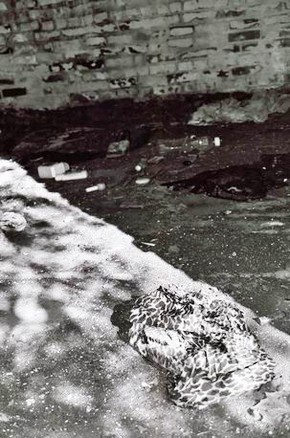 and likely encompassed the land the brick factory sits on now. Mr. Hammond decided to get into shipping and storing stuff, mostly agricultural products. To this end, he built some warehouses in what is now Harrisburg, GA, and soon found himself in very stiff competition with
and likely encompassed the land the brick factory sits on now. Mr. Hammond decided to get into shipping and storing stuff, mostly agricultural products. To this end, he built some warehouses in what is now Harrisburg, GA, and soon found himself in very stiff competition with 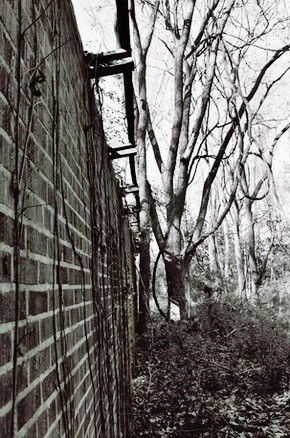 And though, like Campbell Town, these woods are now doomed, Mr. Hammond will gain an even more prestigious immortality via the
And though, like Campbell Town, these woods are now doomed, Mr. Hammond will gain an even more prestigious immortality via the 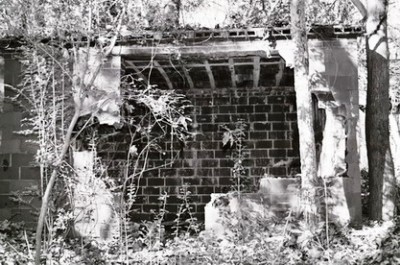
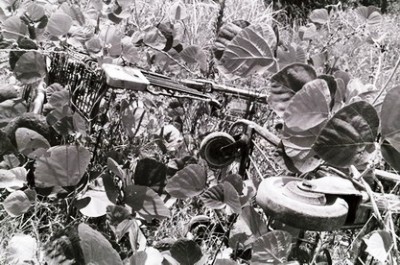
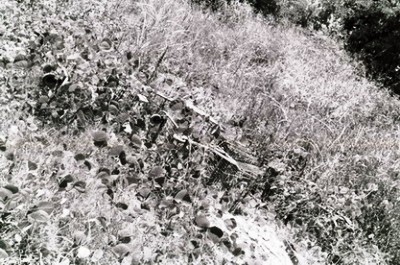
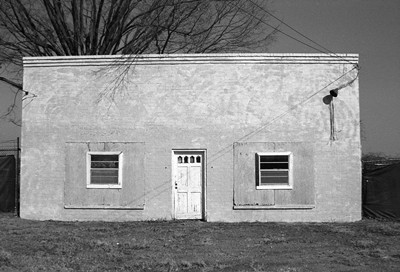
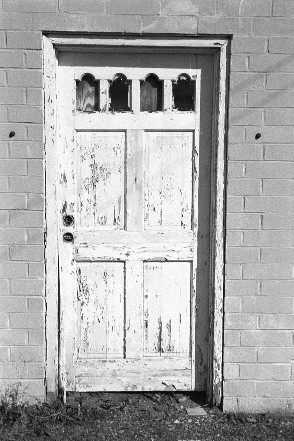 I've already mentioned that the original site of the Sand Bar Ferry, on the river, used to be a popular
I've already mentioned that the original site of the Sand Bar Ferry, on the river, used to be a popular 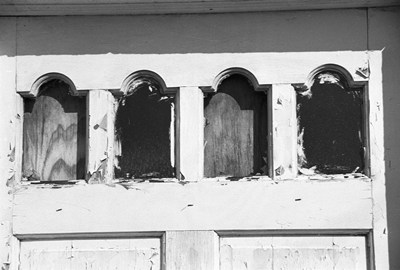
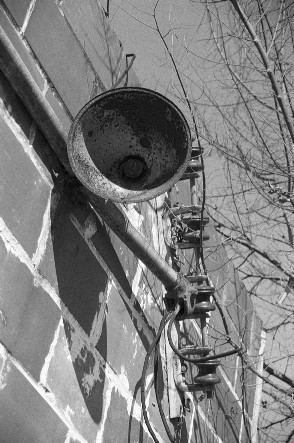 But the Metro Spirit article pointed out that things are improving. Residents were quick to mention this, as well. There are a few churches, a couple convenience stores, a record store (The Dirty Souff), and a beauty parlor, which keep things active. Also, folks from the welding and repair shops are usually outside, talking to customers and passersby, and this street life helps any neighborhood. Although there are a number of residential homes along the road, on the Saturday morning I took these photos there was not a soul around. It would sure be nice if they could find a tenant for the
But the Metro Spirit article pointed out that things are improving. Residents were quick to mention this, as well. There are a few churches, a couple convenience stores, a record store (The Dirty Souff), and a beauty parlor, which keep things active. Also, folks from the welding and repair shops are usually outside, talking to customers and passersby, and this street life helps any neighborhood. Although there are a number of residential homes along the road, on the Saturday morning I took these photos there was not a soul around. It would sure be nice if they could find a tenant for the 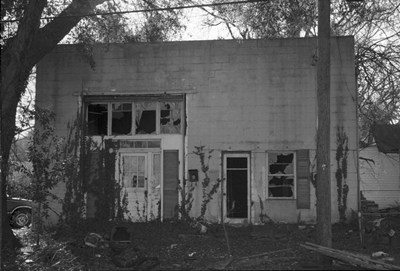
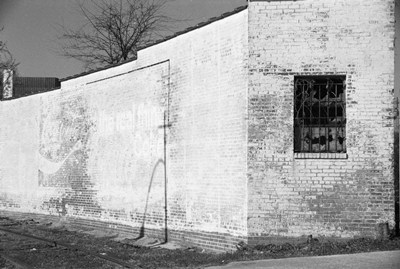
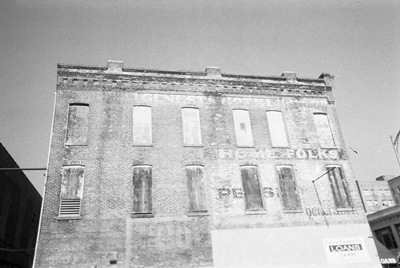

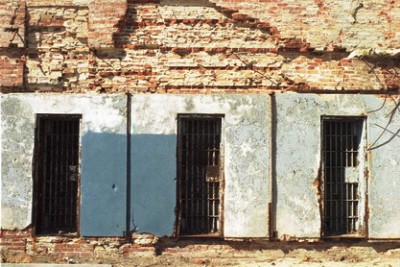
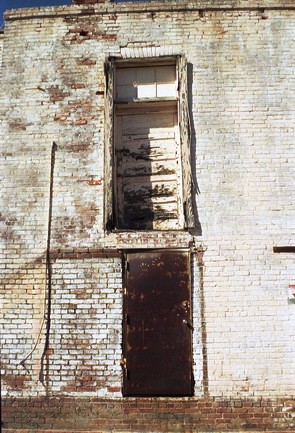 But it's been a great way to process the experiences of the last three or four years and flush the mental vaults, hopefully in preparation for restocking by three or four years of equally intense experiences. That said, I've been really gratified to find that some people do read this thing, or at least look at the pictures, which is good enough. Some of these people I don't even know! I've appreciated all the comments, and its been fun to "meet" a bunch of folks through cyberspace. This is just a long-winded way of saying I don't think I'll be able to actually "quit." We're smack in the middle of downtown here. People exiting this building off the second floor have not been happy.
But it's been a great way to process the experiences of the last three or four years and flush the mental vaults, hopefully in preparation for restocking by three or four years of equally intense experiences. That said, I've been really gratified to find that some people do read this thing, or at least look at the pictures, which is good enough. Some of these people I don't even know! I've appreciated all the comments, and its been fun to "meet" a bunch of folks through cyberspace. This is just a long-winded way of saying I don't think I'll be able to actually "quit." We're smack in the middle of downtown here. People exiting this building off the second floor have not been happy.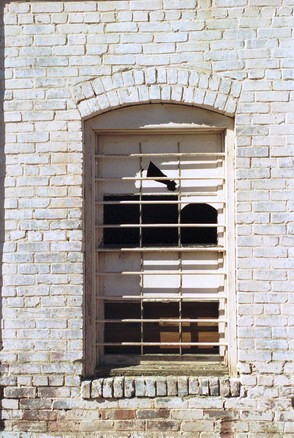 However, there will be some significant changes. I've thought about just what those changes might be, and I think I can say a couple of things. First, posts will get MUCH less text-y, and the focus will be primarily on photographs. I don't foresee having the time to crank out these huge posts in the future, nor will I have the inclination to include so many shots. While it may have been delusional, I've told myself that I've been "documenting" a specific piece of the CSRA for the last 9 months, and so I've put up tons of photos. I've hoped that the pictures complemented the text and maybe provided some atmosphere. However, not all of them were of the highest "artistic merit." Well, hell, what do I know about "artistic merit"? I'll continue to post the shots I like, regardless. There'll just be fewer of them (and they'll be a little larger). A window adjacent to the above doors.
However, there will be some significant changes. I've thought about just what those changes might be, and I think I can say a couple of things. First, posts will get MUCH less text-y, and the focus will be primarily on photographs. I don't foresee having the time to crank out these huge posts in the future, nor will I have the inclination to include so many shots. While it may have been delusional, I've told myself that I've been "documenting" a specific piece of the CSRA for the last 9 months, and so I've put up tons of photos. I've hoped that the pictures complemented the text and maybe provided some atmosphere. However, not all of them were of the highest "artistic merit." Well, hell, what do I know about "artistic merit"? I'll continue to post the shots I like, regardless. There'll just be fewer of them (and they'll be a little larger). A window adjacent to the above doors. 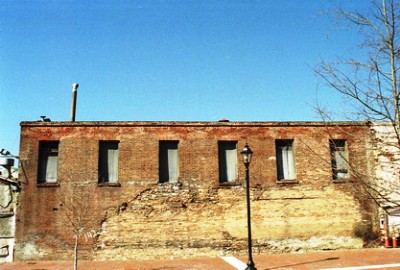
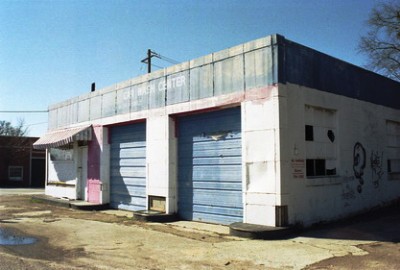
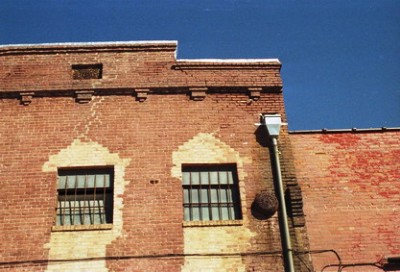
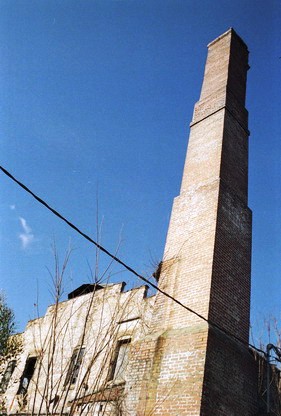 So, I feel pretty good about where City of Dust has been. Photographically, we'll go all around the country from here, and hopefully the world. Unfortunately, for most of my life I haven't even owned a camera, so I'm sort of starting from scratch. Again, thanks to everyone that's written in and said they enjoy the stories and the photos. It's been very much appreciated and, you know, there's no reason to STOP doing that stuff! This shot and the photo below are of Hulse's Laundry, which we've seen a little of
So, I feel pretty good about where City of Dust has been. Photographically, we'll go all around the country from here, and hopefully the world. Unfortunately, for most of my life I haven't even owned a camera, so I'm sort of starting from scratch. Again, thanks to everyone that's written in and said they enjoy the stories and the photos. It's been very much appreciated and, you know, there's no reason to STOP doing that stuff! This shot and the photo below are of Hulse's Laundry, which we've seen a little of 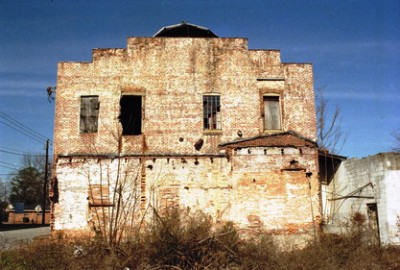
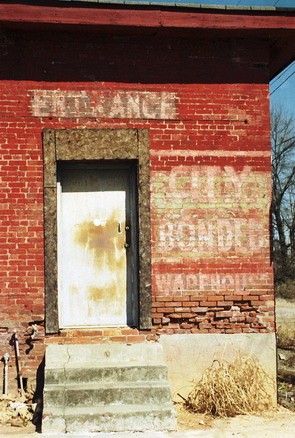 Last time, we were leaving James Brown Blvd. and heading downtown. However,
Last time, we were leaving James Brown Blvd. and heading downtown. However, 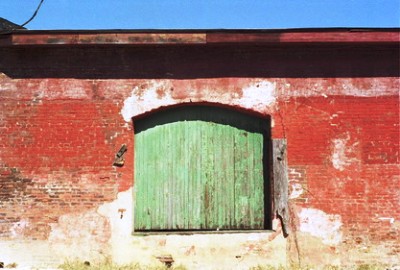
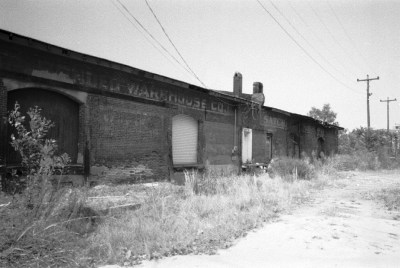
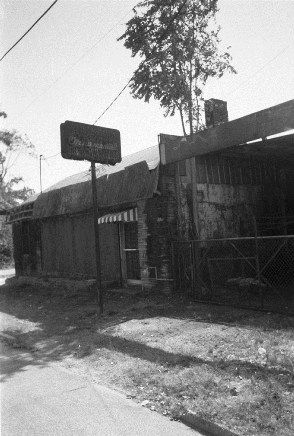 As I mentioned, I don't know anyone that can tell me much about this part of the flats. In all honesty, it's probably best that way. Most of my friends in Augusta, like me, are white males, considered to have only two reasons for being in this particular area: 1.) drugs; and/or 2.) prostitutes. It's unfortunate, but residents and police, not to mention dealers and hookers, all know that to be the case. Therefore, it seems disrespectful to me to go into these neighborhoods to "check it out, man," when these folks are having a hard enough time without wacko urban tourists coming down and getting themselves into trouble. This is a mysterious photo of the Augusta Iron Works, actually very close to James Brown Blvd., and a street down from Walton Way. I know you can't see much, but there it is. At least for now.
As I mentioned, I don't know anyone that can tell me much about this part of the flats. In all honesty, it's probably best that way. Most of my friends in Augusta, like me, are white males, considered to have only two reasons for being in this particular area: 1.) drugs; and/or 2.) prostitutes. It's unfortunate, but residents and police, not to mention dealers and hookers, all know that to be the case. Therefore, it seems disrespectful to me to go into these neighborhoods to "check it out, man," when these folks are having a hard enough time without wacko urban tourists coming down and getting themselves into trouble. This is a mysterious photo of the Augusta Iron Works, actually very close to James Brown Blvd., and a street down from Walton Way. I know you can't see much, but there it is. At least for now. 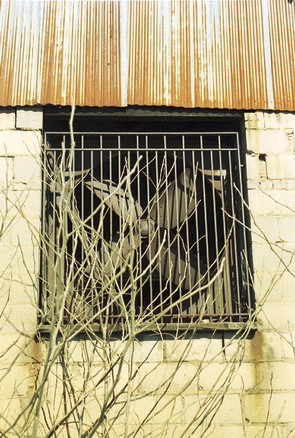 But there were also well-kept homes with flowers and lawns, and it was the looks I received from the owners of these residences, more than anything, that convinced me not to start wandering around. They didn't look pleased to see me, and followed my car closely as I passed. I don't consider this racism, nor do I believe it's a class issue (my car is worth about $300). As I mentioned, it's likely these people simply figured I must be looking for drugs, prostitutes, or some kind of trouble. To get out and start walking around with a camera, taking pictures, would be the height of audacity/stupidity. This is the back of the Augusta Iron Works.
But there were also well-kept homes with flowers and lawns, and it was the looks I received from the owners of these residences, more than anything, that convinced me not to start wandering around. They didn't look pleased to see me, and followed my car closely as I passed. I don't consider this racism, nor do I believe it's a class issue (my car is worth about $300). As I mentioned, it's likely these people simply figured I must be looking for drugs, prostitutes, or some kind of trouble. To get out and start walking around with a camera, taking pictures, would be the height of audacity/stupidity. This is the back of the Augusta Iron Works.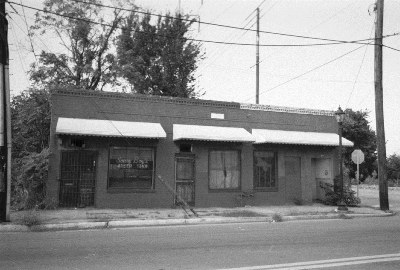
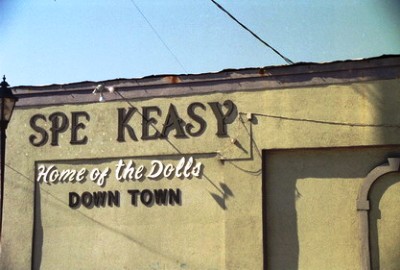
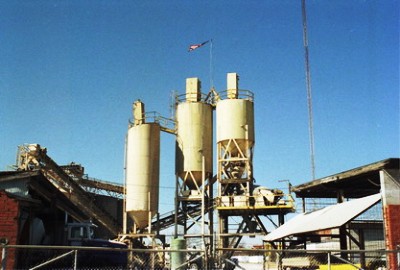
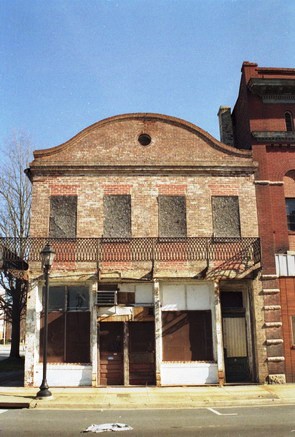 I hear ya. You're saying, "Oh geez, how many pictures of dilapidated buildings and empty streets can a person take?" But bear with me. This post, in combination with the
I hear ya. You're saying, "Oh geez, how many pictures of dilapidated buildings and empty streets can a person take?" But bear with me. This post, in combination with the 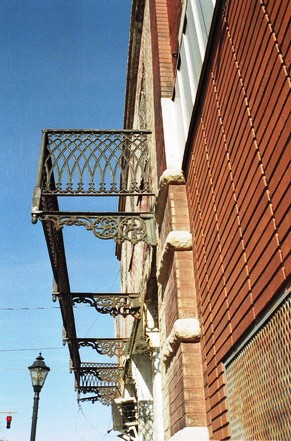 He spent the next four years in the county jail, on a juvenile work farm, and in a group home. Upon release, he joined the Gospel Starlighters, a vocal group led by Bobby Byrd. Soon, the group changed their name to the Famous Flames, shifted from gospel to r & b tunes, and moved James out front. James married his first wife, Velma, and, in 1956, after recording "Please, Please, Please" at WIBB in Macon, GA, the Famous Flames signed to Federal/King Records for $200. "Please, Please, Please" went to #5 on the r & b charts. In 1957, Little Richard renounced rock and roll for that other religion. Namely, religion. James and the Famous Flames picked up all the dates Little Richard had booked and also picked up a few of Richard's band members. Things really got rolling and "Try Me" was released in the fall of 1958, hitting #1 in the r & b charts, where it became the best-selling single of the year. This is the balcony of the above building. Another rare recurrence, this building also appears in b & w in
He spent the next four years in the county jail, on a juvenile work farm, and in a group home. Upon release, he joined the Gospel Starlighters, a vocal group led by Bobby Byrd. Soon, the group changed their name to the Famous Flames, shifted from gospel to r & b tunes, and moved James out front. James married his first wife, Velma, and, in 1956, after recording "Please, Please, Please" at WIBB in Macon, GA, the Famous Flames signed to Federal/King Records for $200. "Please, Please, Please" went to #5 on the r & b charts. In 1957, Little Richard renounced rock and roll for that other religion. Namely, religion. James and the Famous Flames picked up all the dates Little Richard had booked and also picked up a few of Richard's band members. Things really got rolling and "Try Me" was released in the fall of 1958, hitting #1 in the r & b charts, where it became the best-selling single of the year. This is the balcony of the above building. Another rare recurrence, this building also appears in b & w in 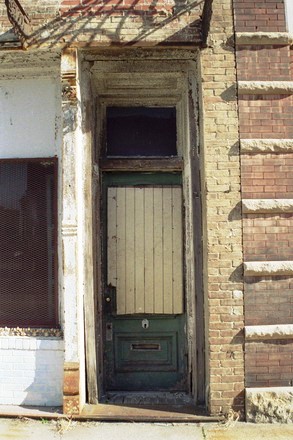 Later that year, he signed with Polydor and shortly afterward released "Get on the Good Foot," which reached #18 in the Top 40 and eventually sold a million copies. James started to call himself "The Godfather of Soul," a title which appeared not unwarranted. In 1973, James' eldest son, Teddy, was killed in an auto accident. The following year, The Payback was issued, featuring long, dense jams, the shortest of which was 5:52. (The longest, "Time is Running Out Fast," clocked in at 12:47.) It became Brown's only gold album, selling over 500,000 copies. That same year, James played "The Rumble in the Jungle," the music festival-cum-Ali/Foreman fight held in Zaire. I guess that was Don King's idea. Oh, and the IRS wanted $4.5 million in back taxes, ensuring that the Hardest Working Man in Show Business remained so. Here's a thin green door. I do not know what's behind it.
Later that year, he signed with Polydor and shortly afterward released "Get on the Good Foot," which reached #18 in the Top 40 and eventually sold a million copies. James started to call himself "The Godfather of Soul," a title which appeared not unwarranted. In 1973, James' eldest son, Teddy, was killed in an auto accident. The following year, The Payback was issued, featuring long, dense jams, the shortest of which was 5:52. (The longest, "Time is Running Out Fast," clocked in at 12:47.) It became Brown's only gold album, selling over 500,000 copies. That same year, James played "The Rumble in the Jungle," the music festival-cum-Ali/Foreman fight held in Zaire. I guess that was Don King's idea. Oh, and the IRS wanted $4.5 million in back taxes, ensuring that the Hardest Working Man in Show Business remained so. Here's a thin green door. I do not know what's behind it. 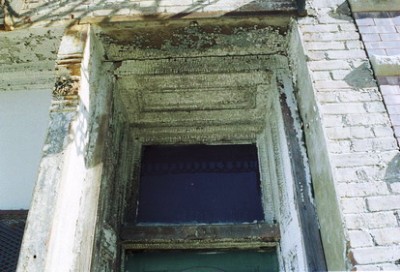
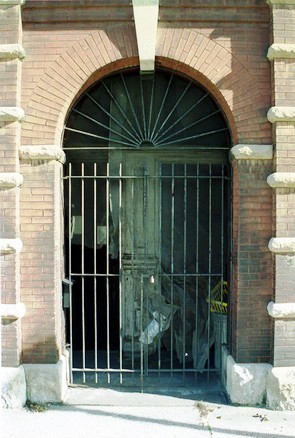 In December 1988, James Brown was sentenced to 8 years in prison. He was paroled on February 21, 1991 for good behavior, and immediately had new eyebrows tattooed onto his face. (Not so strange, really. Donald Trump had similar work done.) The eyebrows were completed just in time for James to be given a Lifetime Achievement Award at the 1992 Grammy Awards. The next year, MC Hammer presented James with a Lifetime Achievement Award at the 4th Annual Rhythm & Blues Foundation Pioneer Awards. In November 1993, 9th St. became James Brown Blvd. and November 20 was declared James Brown Day in Augusta because, among other things, "James Brown is a musical phenomenon affectionately known as `The Godfather of Soul.'" Here's another door. See, there's just no way inside these buildings.
In December 1988, James Brown was sentenced to 8 years in prison. He was paroled on February 21, 1991 for good behavior, and immediately had new eyebrows tattooed onto his face. (Not so strange, really. Donald Trump had similar work done.) The eyebrows were completed just in time for James to be given a Lifetime Achievement Award at the 1992 Grammy Awards. The next year, MC Hammer presented James with a Lifetime Achievement Award at the 4th Annual Rhythm & Blues Foundation Pioneer Awards. In November 1993, 9th St. became James Brown Blvd. and November 20 was declared James Brown Day in Augusta because, among other things, "James Brown is a musical phenomenon affectionately known as `The Godfather of Soul.'" Here's another door. See, there's just no way inside these buildings. 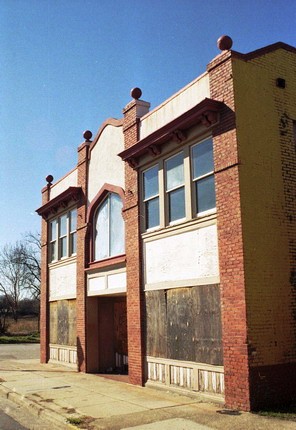 In 1996, Adrienne died from complications while having liposuction surgery. James received a star on the Hollywood Walk of Fame in 1997, but in 1999 a former employee, Lisa Agbalaya-Ross, claimed he'd told her he had powerful testicles which he'd received from the government. She promptly sued him for sexual harassment to the tune of $1 million. In January 2002, Brown married wife #4, Tomi Rae Hynie, and was also cleared of the harassment charges. On January 28, 2004, Brown was arrested once again for domestic violence, causing the city of Augusta to cancel his appearance that spring, a performance that was to coincide with the unveiling of a statue (subsequently re-veiled), and the re-naming of the Garden City Music Fest to the James Brown Music Fest (subsequently un-renamed). James' dishevelled mug shot was shown nationally. We could see inside this old church-like building from the roof of
In 1996, Adrienne died from complications while having liposuction surgery. James received a star on the Hollywood Walk of Fame in 1997, but in 1999 a former employee, Lisa Agbalaya-Ross, claimed he'd told her he had powerful testicles which he'd received from the government. She promptly sued him for sexual harassment to the tune of $1 million. In January 2002, Brown married wife #4, Tomi Rae Hynie, and was also cleared of the harassment charges. On January 28, 2004, Brown was arrested once again for domestic violence, causing the city of Augusta to cancel his appearance that spring, a performance that was to coincide with the unveiling of a statue (subsequently re-veiled), and the re-naming of the Garden City Music Fest to the James Brown Music Fest (subsequently un-renamed). James' dishevelled mug shot was shown nationally. We could see inside this old church-like building from the roof of 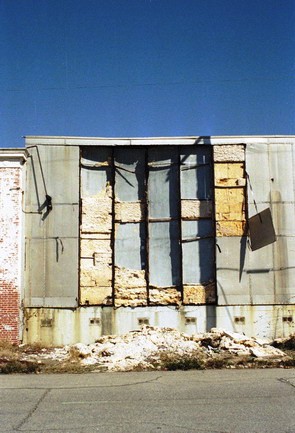 The man may have banned computers from his office because he believes they can watch him, but only Elvis Presley has had more hit records. Until recently, Brown used to hang around his radio station downtown, which, I believe, is now defunct. One day, a friend of mine saw him hanging a display in the window and waved. James pointed back, smiled, and did a little spin and shuffle. James Brown: "I fear God. I fear a man with a gun. I fear a man with a knife. I fear a fool behind the wheel. That's what I fear. I fear death. Death may come to me. I may not run from it like a lot of people if my rights is there. I put my rights first, 'cause if I can't live then I'm already dead." And so we leave JB Blvd., and head down Walker St., never to return. Info for this post came from the Hall of Fame biography and
The man may have banned computers from his office because he believes they can watch him, but only Elvis Presley has had more hit records. Until recently, Brown used to hang around his radio station downtown, which, I believe, is now defunct. One day, a friend of mine saw him hanging a display in the window and waved. James pointed back, smiled, and did a little spin and shuffle. James Brown: "I fear God. I fear a man with a gun. I fear a man with a knife. I fear a fool behind the wheel. That's what I fear. I fear death. Death may come to me. I may not run from it like a lot of people if my rights is there. I put my rights first, 'cause if I can't live then I'm already dead." And so we leave JB Blvd., and head down Walker St., never to return. Info for this post came from the Hall of Fame biography and 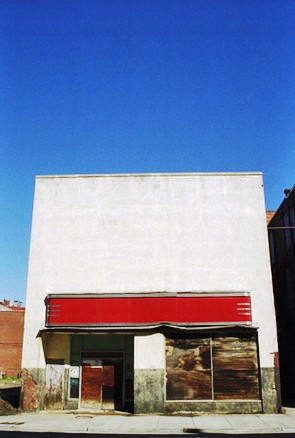 Okay, I've returned from my little jaunt through the South. The weather was beautiful in New Orleans, we stopped by
Okay, I've returned from my little jaunt through the South. The weather was beautiful in New Orleans, we stopped by 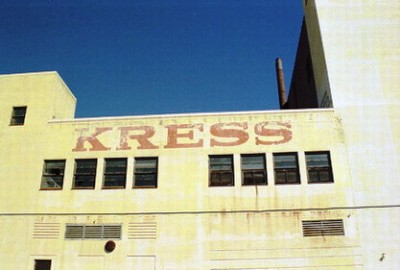
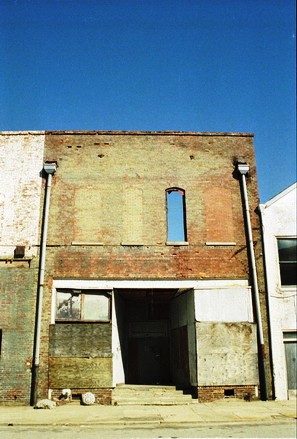 Now, the Augusta Arsenal used to be near the river and, consequently, soldiers were always turning yellow, getting enlarged spleens, and dying like flies. Captain Matthew Payne visited Freeman Walker in his house up on The Hill in an attempt to regain his own health afer a bout of fever. While there, the Captain realized that the men at the Arsenal might not die so often if they were up on the hill too. So, construction of a new Augusta Arsenal began, right beside Bellevue. This was in the mid-late 1820's. Now, having dodged some construction equipment and a few stray dogs, we're just a bit further down Ellis St.
Now, the Augusta Arsenal used to be near the river and, consequently, soldiers were always turning yellow, getting enlarged spleens, and dying like flies. Captain Matthew Payne visited Freeman Walker in his house up on The Hill in an attempt to regain his own health afer a bout of fever. While there, the Captain realized that the men at the Arsenal might not die so often if they were up on the hill too. So, construction of a new Augusta Arsenal began, right beside Bellevue. This was in the mid-late 1820's. Now, having dodged some construction equipment and a few stray dogs, we're just a bit further down Ellis St. Just as the Civil War was on the horizon, the Federal Government sent 22,000 muskets and rifles up to the Arsenal under the guard of Captain Arnold Elzey. In January of 1861, Elzey surrendered the Arsenal and its arsenal to Colonel W.H. Walker of the Confederate Army. Elzey then joined the Confederacy and was promptly promoted to Colonel himself. By this time, Freeman Walker was long dead and John Galt lived at Bellevue with his two daughters, Emily and Lucy. I'm assuming both daughters were very beautiful and prone to swooning, but I can't verify that. We've taken a left turn and walked down the street to Telfair. I rarely take more than one shot of something, but I've got at least three of this sign. I dunno why. I guess I just like it. There's another
Just as the Civil War was on the horizon, the Federal Government sent 22,000 muskets and rifles up to the Arsenal under the guard of Captain Arnold Elzey. In January of 1861, Elzey surrendered the Arsenal and its arsenal to Colonel W.H. Walker of the Confederate Army. Elzey then joined the Confederacy and was promptly promoted to Colonel himself. By this time, Freeman Walker was long dead and John Galt lived at Bellevue with his two daughters, Emily and Lucy. I'm assuming both daughters were very beautiful and prone to swooning, but I can't verify that. We've taken a left turn and walked down the street to Telfair. I rarely take more than one shot of something, but I've got at least three of this sign. I dunno why. I guess I just like it. There's another 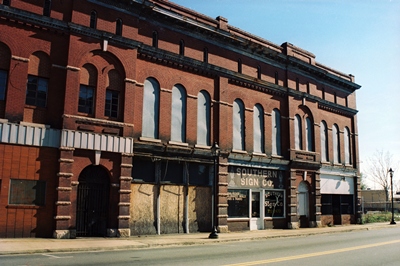
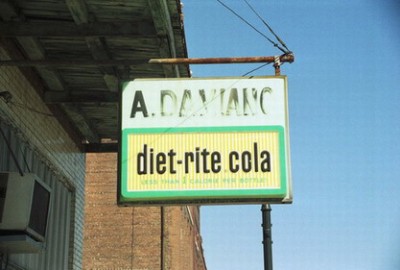
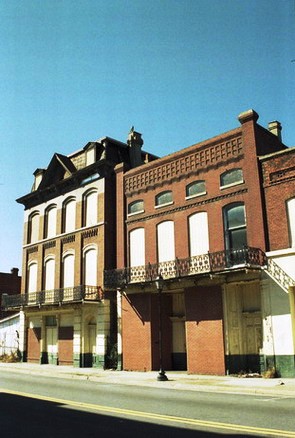 You can bet that I went on a mission one day to look for this window, even if I had to pretend I was an ASU student in need of counselling. Yes, I know, possibly not a stretch. However, it took me awhile to get around to it. Just before I left Augusta I figured I better finally have a look see and, would you believe it, the whole place was closed for renovation. I'm pretty adept at getting into old buildings, but not secure contruction sites in the middle of the day. Or even the middle of the night. So, as they say, I can neither confirm nor deny the veracity of the claims. But, you know, I believe it! Other side of James Brown Blvd. Not much livelier than across the street.
You can bet that I went on a mission one day to look for this window, even if I had to pretend I was an ASU student in need of counselling. Yes, I know, possibly not a stretch. However, it took me awhile to get around to it. Just before I left Augusta I figured I better finally have a look see and, would you believe it, the whole place was closed for renovation. I'm pretty adept at getting into old buildings, but not secure contruction sites in the middle of the day. Or even the middle of the night. So, as they say, I can neither confirm nor deny the veracity of the claims. But, you know, I believe it! Other side of James Brown Blvd. Not much livelier than across the street.